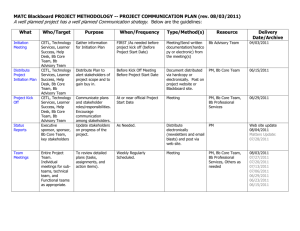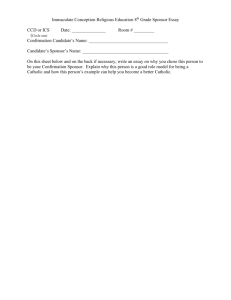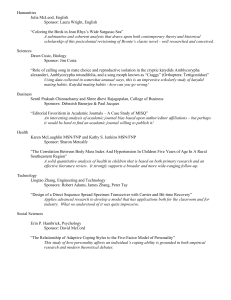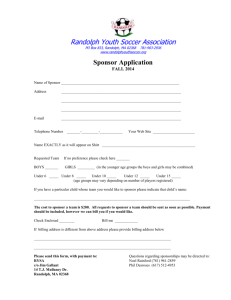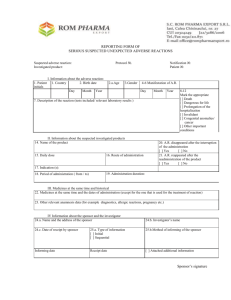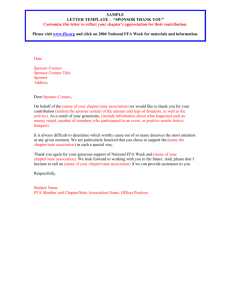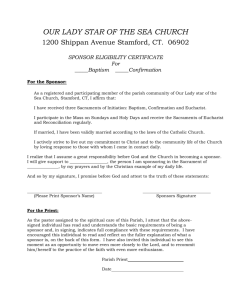PROJECT COMMUNICATION PLAN
advertisement
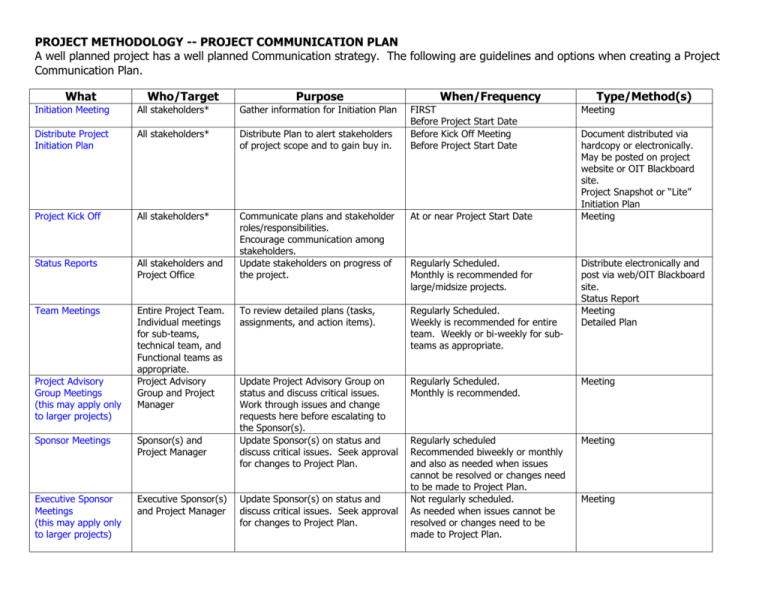
PROJECT METHODOLOGY -- PROJECT COMMUNICATION PLAN A well planned project has a well planned Communication strategy. The following are guidelines and options when creating a Project Communication Plan. What Who/Target Purpose When/Frequency Initiation Meeting All stakeholders* Gather information for Initiation Plan Distribute Project Initiation Plan All stakeholders* Distribute Plan to alert stakeholders of project scope and to gain buy in. Project Kick Off All stakeholders* At or near Project Start Date Status Reports All stakeholders and Project Office Communicate plans and stakeholder roles/responsibilities. Encourage communication among stakeholders. Update stakeholders on progress of the project. Team Meetings Entire Project Team. Individual meetings for sub-teams, technical team, and Functional teams as appropriate. Project Advisory Group and Project Manager To review detailed plans (tasks, assignments, and action items). Regularly Scheduled. Weekly is recommended for entire team. Weekly or bi-weekly for subteams as appropriate. Update Project Advisory Group on status and discuss critical issues. Work through issues and change requests here before escalating to the Sponsor(s). Update Sponsor(s) on status and discuss critical issues. Seek approval for changes to Project Plan. Regularly Scheduled. Monthly is recommended. Meeting Regularly scheduled Recommended biweekly or monthly and also as needed when issues cannot be resolved or changes need to be made to Project Plan. Not regularly scheduled. As needed when issues cannot be resolved or changes need to be made to Project Plan. Meeting Project Advisory Group Meetings (this may apply only to larger projects) Sponsor Meetings Sponsor(s) and Project Manager Executive Sponsor Meetings (this may apply only to larger projects) Executive Sponsor(s) and Project Manager Update Sponsor(s) on status and discuss critical issues. Seek approval for changes to Project Plan. FIRST Before Project Start Date Before Kick Off Meeting Before Project Start Date Type/Method(s) Regularly Scheduled. Monthly is recommended for large/midsize projects. Meeting Document distributed via hardcopy or electronically. May be posted on project website or OIT Blackboard site. Project Snapshot or “Lite” Initiation Plan Meeting Distribute electronically and post via web/OIT Blackboard site. Status Report Meeting Detailed Plan Meeting What Who/Target Project Audit/Review Project Office, Project Manager, select stakeholders, and possibly Sponsor(s) if necessary. Project Office, Project Manager, key stakeholders, and sponsor(s). Project Office, Project Manager, and key stakeholders. Review status reports, issues, and risks. To identify and communicate potential risks and issues that may affect the schedule, budget or deliverables. Monthly Scheduled by the Project Office Meeting/Report Project Office will produce report using their template. Identify improvement plans, lessons learned, what worked and what could have gone better. Review accomplishments. Review overall health of the project and highlight areas that need action. End of Project or end of major phase Meeting/Report Project Office will produce report. Quarterly depending on size and criticality of the project. Scheduled by the Project Office. Examples: PMT (Project Managers Team), OIT Leadership Group, AIS Quarterly Review, AMG (Academic Managers Group), etc. Project Team Members To update external groups to promote communication a create awareness of project interdependencies. At project milestones so as to communicate with other interested parties of changes that will be introduced outside of the Project Team. Meeting/Report Project Office will produce report using internal template. Presentation/Demonstration Central location to house Status Reports, meeting minutes, Project description, and Project Plan. For any communications that can be shared with all staff. To gain input from special groups and keep them abreast of the Project’s status. Update monthly with Status Reports; otherwise, as necessary. Electronic Communications Venue Once product has enough to “show”. As you complete critical phases or make major enhancements. Presentation/Discussion General communications As needed Post Project Review Quarterly Project Review Presentations to Special Interest Groups Document Sharing Site Periodic Demos and Target Presentations Specific Focus Groups or End Users Examples: AMG (Academic Managers Group), Students, Power Users, Help Desk, Dept Mgrs., etc. Other… To be determined by the Project Team Purpose When/Frequency Type/Method(s) PAW, PWB, Lunch n Learns, email lists, PU home page announcements, etc. Project Methodology describes stakeholders as: “…any person or group who has a vested interest in the success of the project, i.e. either provides services to the project, or receives services from the project. A key stakeholder is defined as: A person whose support is critical to the project – if the support of a key stakeholder were to be withdrawn, the project would fail.”

